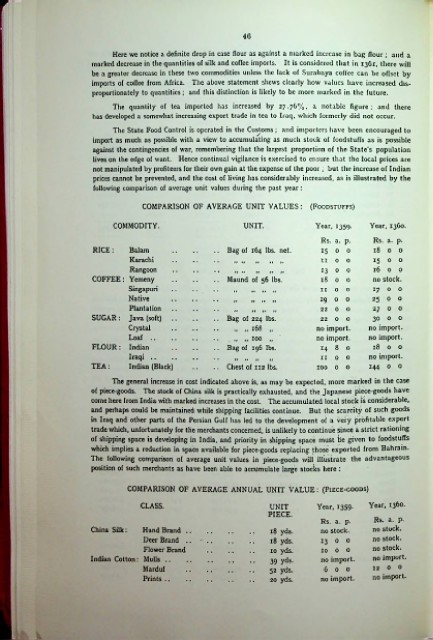Page 406 - Bahrain Gov Annual Reports (II)_Neat
P. 406
4G
Here we notice a definite drop in case flour as against a marked increase in bag flour ; and a
marked decrease in the quantities of silk and coffee imports. It is considered that in 1361, there will
be a greater decrease in these two commodities unless the lack of Surabaya coffee can be offset by
imports of coffee from Africa. The above statement shews clearly how values have increased dis
proportionately to quantities; and this distinction is likely to be more marked in the future.
The quantity of tea imported has increased by 27.76%, a notable figure; and there
has developed a somewhat increasing export trade in tea to Iraq, which formerly did not occur.
The State Food Control is operated in the Customs; and importers have been encouraged to
import as much as possible with a view to accumulating as much stock of foodstuffs as is possible
against the contingencies of war, remembering that the largest proportion of the State’s population
lives on the edge of want. Hence continual vigilance is exercised to ensure that the local prices are
not manipulated by profiteers for their own gain at the expense of the poor ; but the increase of Indian
prices cannot be prevented, and the cost of living has considerably increased, as is illustrated by the
following comparison of average unit values duiing the past year:
COMPARISON OF AVERAGE UNIT VALUES: (Foodstuffs)
COMMODITY. UNIT. Year, 1359. Year, 1360.
Rs. a. p. Rs. a. p.
RICE: Balam .. Bag of 164 lbs. net. 15 o 0 18 0 0
Karachi 11 0 0 15 0 0
M I » II If
Rangoon II • • I* II 13 0 0 16 0 0
COFFEE: Yemeny .. Maund of 56 lbs. 18 0 0 no stock.
Singapuri 11 o o 17 0 0
It ••
Native 19 0 o 25 0 0
11 11 11
Plantation 22 0 o 27 o 0
11 ii ii
SUGAR: Java (soft) .. Bag of 224 lbs. 22 0 0 30 0 0
Crystal • • ..168 no import, no import,
Loaf .. .. 100 „ no import. no import.
FLOUR: Indian .. Bag of 196 lbs. 14 8 0 18 o 0
Iraqi .. 11 0 o no import.
11 11 11
TEA: Indian (Black) Chest of 112 lbs. 100 0 0 144 0 0
The general increase in cost indicated above is, as may be expected, more marked in the case
of piece-goods. The stock of China silk is practically exhausted, and the Japanese piece-goods have
come here from India with marked increases in the cost. The accumulated local stock is considerable,
and perhaps could be maintained while shipping facilities continue. But the scarcity of such goods
in Iraq and other parts of the Persian Gulf has led to the development of a very profitable export
trade which, unfortunately for the merchants concerned, is unlikely to continue since a strict rationing
of shipping space is developing in India, and priority in shipping space must be given to foodstuffs
which implies a reduction in space available for piece-goods replacing those exported from Bahrain.
The following comparison of average unit values in piece-goods will illustrate the advantageous
position of such merchants as have been able to accumulate large stocks here:
COMPARISON OF AVERAGE ANNUAL UNIT VALUE: (Piece-goods)
CLASS. UNIT Year, 1359- Year, 1360.
PIECE.
Rs. a. p. Rs. a. p.
China Silk: Hand Brand .. 18 yds. no stock. no stock,
Deer Brand .. 18 yds. 13 0 o no stock,
Flower Brand 10 yds. 10 0 0 no stock,
Indian Cotton: Mulls .. 39 yds. no import. no import.
Marduf 52 yds. 600 12 o 0
Prints .. 20 yds. no import. no import.

